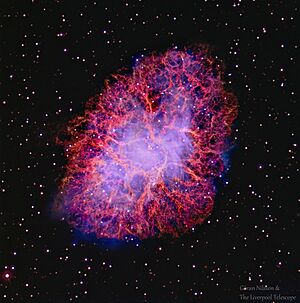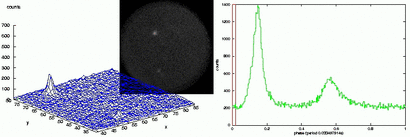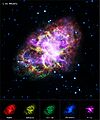Crab Nebula facts for kids
 statistic, see tau-a.
statistic, see tau-a.| Supernova remnant | |
|---|---|
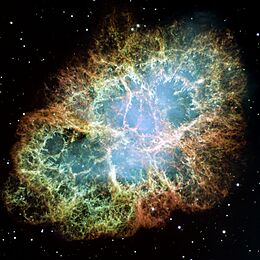
Hubble Space Telescope mosaic image assembled from 24 individual Wide Field and Planetary Camera 2 exposures taken in October 1999, January 2000, and December 2000
|
|
| Observation data: J2000.0 epoch | |
| Right ascension | 05h 34m 31.94s |
| Declination | +22° 00′ 52.2″ |
| Distance | 6500±1600 ly (2000±500 pc) |
| Apparent magnitude (V) | 8.4 |
| Apparent dimensions (V) | 420″ × 290″ |
| Constellation | Taurus |
| Physical characteristics | |
| Radius | ~5.5 ly (~1.7 pc) |
| Absolute magnitude (V) | −3.1±0.5 |
| Notable features | Optical pulsar |
| Designations | Messier 1, NGC 1952, Taurus A, Sh2-244 |
The Crab Nebula (also called M1, NGC 1952, or Taurus A) is a cloud of gas and dust in space. It is what's left after a giant star exploded. This explosion is called a supernova. The nebula is found in the constellation of Taurus.
The name "Crab Nebula" comes from a drawing made in 1842 or 1843. An astronomer named William Parsons, 3rd Earl of Rosse, drew it. He thought it looked a bit like a crab with arms. The nebula was first found by English astronomer John Bevis in 1731. It is linked to a very bright supernova. This supernova was seen and recorded by Chinese astronomers in the year 1054. It was the first time scientists connected an object in space to a past supernova explosion.
The Crab Nebula is not bright enough to be seen with just your eyes. It has an apparent magnitude of 8.4. You might be able to see it with binoculars if the sky is very dark. The nebula is about 6,500 light-years away from Earth. It is located in the Perseus Arm of our Milky Way galaxy. The nebula is about 11 light-years wide. It is still growing, expanding at about 1,500 kilometers per second. This is about 0.5% of the speed of light.
At the center of the Crab Nebula is the Crab Pulsar. This is a tiny, super-dense star called a neutron star. It is only about 28 to 30 kilometers across. The pulsar spins very fast, about 30 times every second. As it spins, it sends out bursts of radiation. This radiation ranges from powerful gamma rays to radio waves. The Crab Nebula is one of the brightest sources of gamma rays in the sky. Scientists use the nebula's radiation to study other space objects. For example, they mapped the Sun's outer atmosphere (the solar corona) by watching how it affected the nebula's radio waves. In 2003, they even measured the thickness of Saturn's moon Titan's atmosphere. They did this by seeing how it blocked X-rays from the nebula.
Contents
How We Discovered the Crab Nebula
Scientists now know that the Crab Nebula was formed by a supernova. This supernova was first seen in 1054. Chinese and Japanese astronomers recorded it. They called it a "guest star" because it appeared suddenly.
First Sightings of the Nebula

The Crab Nebula was first officially found by John Bevis in 1731. Later, in 1758, Charles Messier found it again. He was looking for a comet that was expected to return. Messier thought the nebula might be the comet at first. But he soon realized it wasn't moving.
This made Messier start a list of cloudy objects that stayed in the same place. He wanted to help other astronomers avoid confusing them with comets. This list became the famous "Messier catalogue." The Crab Nebula was the very first object on his list.
William Herschel also observed the Crab Nebula many times. This was between 1783 and 1809. He thought it was a group of stars. Later, in the 1840s, William Parsons, 3rd Earl of Rosse, drew the nebula. His drawing showed it with arms, like a crab. This is how it got its common name.
Connecting the Nebula to the 1054 Supernova
The Crab Nebula was the first object in space linked to a supernova explosion. In the early 1900s, scientists looked at old photographs of the nebula. They noticed it was getting bigger. By tracing its expansion backward, they figured out it must have appeared about 900 years earlier.
Then, they looked at old records. They found that Chinese astronomers had written about a new, very bright star. It appeared in the same part of the sky on July 4, 1054. Japanese observers also saw it.
In 1928, Edwin Hubble suggested that this "guest star" was the supernova that created the Crab Nebula. This idea became widely accepted. This discovery helped scientists understand supernovae much better. They then started looking for other historical supernovae.
The supernova in 1054 was so bright that it could be seen during the daytime. It was even brighter than the planet Venus. It stayed visible to the naked eye for about two years.
The Crab Pulsar Discovery
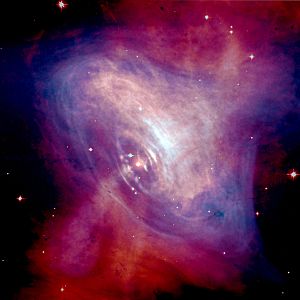
In the 1960s, scientists discovered objects called pulsars. This made the Crab Nebula very interesting again. In 1968, scientists found a rapidly pulsing radio source in the Crab Nebula. They named it NP 0532. It pulsed every 33 milliseconds.
This discovery proved that pulsars are rapidly spinning neutron stars. It also showed that the energy from the spinning pulsar powers the Crab Nebula. The Crab Pulsar is very important for science. Its exact age is known, which helps scientists study neutron stars.
The central part of the Crab Nebula is filled with a "pulsar wind nebula." This is energy and particles blowing out from the pulsar. The Crab Nebula is a great example of both a supernova remnant and a pulsar wind nebula.
High-Energy Gamma Rays
The Crab Nebula was the first object in space confirmed to send out very high-energy gamma rays. This was discovered in 1989. In 2019, scientists observed the Crab Nebula emitting gamma rays even more powerful than before. This made it the first known source of gamma rays above 100 TeV.
What the Crab Nebula is Like
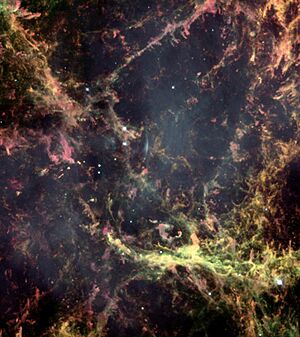
When you look at the Crab Nebula with a telescope, it looks like an oval shape. It is about 6 arcminutes long and 4 arcminutes wide. (For comparison, the full moon is 30 arcminutes across.) It has a blue glow in the middle.
The nebula is made of thin threads of gas. These threads are what's left of the star's outer layers. They are mostly made of ionized helium and hydrogen. They also contain carbon, oxygen, nitrogen, iron, neon, and sulfur. These gas threads are very hot, between 11,000 and 18,000 K.
The blue glow in the middle of the nebula comes from something called synchrotron radiation. This is light given off by electrons moving very fast in a magnetic field. These electrons move at almost half the speed of light. The strong magnetic field comes from the neutron star at the center.
How Far Away is It?
Even though scientists study the Crab Nebula a lot, its exact distance is still a bit uncertain. Most scientists agree it is about 6,500 light-years from Earth. This means it is about 11 light-years wide.
The nebula is still expanding outward at about 1,500 kilometers per second. Scientists can measure how much it has expanded over several years. By comparing this to how fast the gas is moving, they can estimate its distance.
How Much Does It Weigh?
Scientists estimate the total mass of the gas in the Crab Nebula. This helps them guess how big the original star was. The gas in the nebula is thought to be about 4.6 times the mass of our Sun.
There is also a part of the nebula that looks like a ring or donut shape. This ring is rich in helium. It makes up about 25% of the visible gas.
The Star at the Center
At the very center of the Crab Nebula are two faint stars. One of them is the star that caused the nebula. Scientists identified it in 1942. In 1968, they found that this star was sending out radiation in rapid pulses. This made it one of the first pulsars ever discovered.
Pulsars are like cosmic lighthouses. They send out strong beams of electromagnetic radiation many times a second. When they were first found, they were a big mystery. Some even wondered if they were signals from aliens! But finding a pulsar in the Crab Nebula showed they come from supernova explosions. We now know they are rapidly spinning neutron stars. Their strong magnetic fields create these powerful beams.
The Crab Pulsar is tiny, only about 28 to 30 kilometers wide. It spins incredibly fast, sending out a pulse of radiation every 33 milliseconds. It sends out pulses across the entire electromagnetic spectrum, from radio waves to X-rays.
Like all pulsars, it is slowly spinning down. This means it loses energy. This huge amount of energy powers the bright glow of the Crab Nebula. The nebula shines with a total luminosity about 75,000 times brighter than our Sun.
The area around the Crab Pulsar is very active. Most objects in space change very slowly. But the inner parts of the Crab Nebula change in just a few days. The pulsar's strong wind of particles crashes into the nebula. This creates a "shock front" that constantly shifts and changes.
The Star That Exploded
The star that exploded to create the Crab Nebula is called the progenitor star. There are two main types of stars that explode as supernovae. One type is a white dwarf star that collects too much material. The other type is a very large, massive star that runs out of fuel.
The Crab Nebula has a pulsar at its center. This tells us that it came from a massive star that ran out of fuel and collapsed. This is called a core-collapse supernova.
Scientists think the original star was about 9 to 11 times the mass of our Sun. Stars smaller than 8 solar masses usually don't explode as supernovae. They just form a planetary nebula. Stars much heavier than 12 solar masses would have created a nebula with different chemicals.
One puzzle about the Crab Nebula is that its total mass (the nebula plus the pulsar) is less than what scientists expect from the original star. This "missing mass" is a mystery. One idea is that the star lost a lot of its mass in a fast "stellar wind" before it exploded. But scientists haven't found evidence of this yet.
When Other Objects Pass By
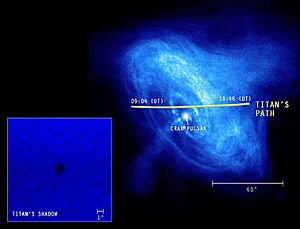
The Crab Nebula is close to the ecliptic. This is the path Earth takes around the Sun. This means that the Moon, and sometimes planets, can pass in front of the nebula. The Sun's outer atmosphere, the solar corona, also passes in front of it.
Scientists can use these events to study both the nebula and the object passing in front of it. They watch how the nebula's radiation changes when something blocks it.
Moon Crossings
When the Moon passes in front of the Crab Nebula, scientists can use it to map the nebula's X-ray emissions. Before X-ray satellites, this was a great way to get detailed X-ray maps.
Sun Crossings
The Sun's corona passes in front of the Crab Nebula every June. By watching how the nebula's radio waves change, scientists learn about the corona's density and structure. Early observations showed the corona was much larger than thought.
Other Planets and Moons
Very rarely, Saturn passes in front of the Crab Nebula. This happened on January 4, 2003. The next time won't be until August 5, 2267! Scientists used the Chandra X-ray Observatory to watch Titan, Saturn's moon, cross the nebula. They found that Titan's X-ray "shadow" was bigger than the moon itself. This was because Titan's atmosphere absorbed some of the X-rays. These observations showed that Titan's atmosphere is about 880 kilometers thick.
Images for kids
-
The Crab Nebula seen in radio, infrared, visible light, ultraviolet, X-rays and gamma-rays (8 March 2015)
-
Crab Nebula imaged using James Webb Space Telescope in infrared via its NIRCam (Near-Infrared Camera) and MIRI (Mid-Infrared Instrument). (30 October 2023)
See also
 In Spanish: Nebulosa del Cangrejo para niños
In Spanish: Nebulosa del Cangrejo para niños
- Lists of nebulae
- List of Messier objects
- Southern Crab Nebula, named because it looks like the Crab Nebula, but seen from the southern part of Earth.


